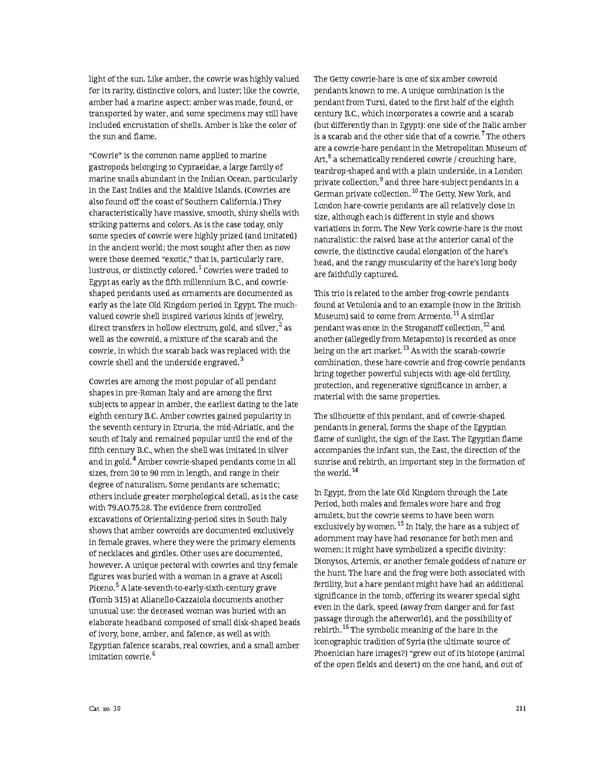light of the sun. Like amber, the cowrie was highly valued The Getty cowrie-hare is one of six amber cowroid for its rarity, distinctive colors, and luster; like the cowrie, pendants known to me. A unique combination is the amber had a marine aspect: amber was made, found, or pendant from Tursi, dated to the first half of the eighth transported by water, and some specimens may still have century B.C., which incorporates a cowrie and a scarab included encrustation of shells. Amber is like the color of (but differently than in Egypt): one side of the Italic amber the sun and flame. is a scarab and the other side that of a cowrie.7 The others are a cowrie-hare pendant in the Metropolitan Museum of “Cowrie” is the common name applied to marine Art,8 a schematically rendered cowrie / crouching hare, gastropods belonging to Cypraeidae, a large family of teardrop-shaped and with a plain underside, in a London marine snails abundant in the Indian Ocean, particularly private collection,9 and three hare-subject pendants in a in the East Indies and the Maldive Islands. (Cowries are German private collection.10 The Getty, New York, and also found off the coast of Southern California.) They London hare-cowrie pendants are all relatively close in characteristically have massive, smooth, shiny shells with size, although each is different in style and shows striking patterns and colors. As is the case today, only variations in form. The New York cowrie-hare is the most some species of cowrie were highly prized (and imitated) naturalistic: the raised base at the anterior canal of the in the ancient world; the most sought after then as now cowrie, the distinctive caudal elongation of the hare’s were those deemed “exotic,” that is, particularly rare, head, and the rangy muscularity of the hare’s long body lustrous, or distinctly colored.1 Cowries were traded to are faithfully captured. Egypt as early as the fifth millennium B.C., and cowrie- shaped pendants used as ornaments are documented as This trio is related to the amber frog-cowrie pendants early as the late Old Kingdom period in Egypt. The much- found at Vetulonia and to an example (now in the British valued cowrie shell inspired various kinds of jewelry, Museum) said to come from Armento.11A similar direct transfers in hollow electrum, gold, and silver,2 as pendant was once in the Stroganoff collection,12 and well as the cowroid, a mixture of the scarab and the another (allegedly from Metaponto) is recorded as once cowrie, in which the scarab back was replaced with the being on the art market.13 As with the scarab-cowrie cowrie shell and the underside engraved.3 combination, these hare-cowrie and frog-cowrie pendants bring together powerful subjects with age-old fertility, Cowries are among the most popular of all pendant protection, and regenerative significance in amber, a shapes in pre-Roman Italy and are among the first material with the same properties. subjects to appear in amber, the earliest dating to the late eighth century B.C. Amber cowries gained popularity in The silhouette of this pendant, and of cowrie-shaped the seventh century in Etruria, the mid-Adriatic, and the pendants in general, forms the shape of the Egyptian south of Italy and remained popular until the end of the flame of sunlight, the sign of the East. The Egyptian flame fifth century B.C., when the shell was imitated in silver accompanies the infant sun, the East, the direction of the and in gold.4 Amber cowrie-shaped pendants come in all sunrise and rebirth, an important step in the formation of sizes, from 20 to 90 mm in length, and range in their the world.14 degree of naturalism. Some pendants are schematic; others include greater morphological detail, as is the case In Egypt, from the late Old Kingdom through the Late with 79.AO.75.28. The evidence from controlled Period, both males and females wore hare and frog excavations of Orientalizing-period sites in South Italy amulets, but the cowrie seems to have been worn exclusively by women.15 In Italy, the hare as a subject of shows that amber cowroids are documented exclusively in female graves, where they were the primary elements adornment may have had resonance for both men and of necklaces and girdles. Other uses are documented, women; it might have symbolized a specific divinity: however. A unique pectoral with cowries and tiny female Dionysos, Artemis, or another female goddess of nature or figures was buried with a woman in a grave at Ascoli the hunt. The hare and the frog were both associated with Piceno.5 A late-seventh-to-early-sixth-century grave fertility, but a hare pendant might have had an additional (Tomb 315) at Alianello-Cazzaiola documents another significance in the tomb, offering its wearer special sight unusual use: the deceased woman was buried with an even in the dark, speed (away from danger and for fast elaborate headband composed of small disk-shaped beads passage through the afterworld), and the possibility of rebirth.16 The symbolic meaning of the hare in the of ivory, bone, amber, and faïence, as well as with Egyptian faïence scarabs, real cowries, and a small amber iconographic tradition of Syria (the ultimate source of imitation cowrie.6 Phoenician hare images?) “grew out of its biotope (animal of the open fields and desert) on the one hand, and out of Cat. no. 30 211
 Ancient Carved Ambers in the J. Paul Getty Museum Page 220 Page 222
Ancient Carved Ambers in the J. Paul Getty Museum Page 220 Page 222